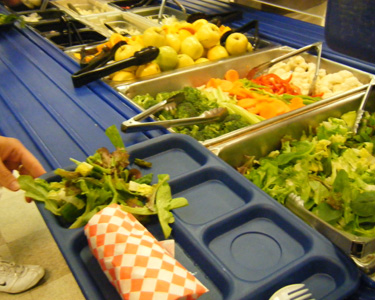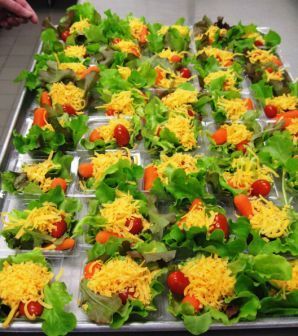Marketing to Schools and Institutions
During the last 20 years, there have been many efforts to retool school and institutional purchasing in ways that can feature local farm products as part of healthy meal options.
Overview

Schools and institutions have long been identified as potential markets for local and regional food crops. These markets have both generated greater interest and purchases during the past 20 years due to consumer interest, food and health policy initiatives, and changes in school and institutional purchasing and procurement systems. Large institutional buyers, from government entities to wholesale food brokers, expanded local and regional sourcing programs.
Barriers and Opportunities
 One barrier for marketing crops to institutional markets, especially for small producers, is supplying adequate quantities of a particular product at satisfactory quality levels and food safety assurances. Institutions interested in purchasing local produce have frequently cited the failure of producers to supply reliable quantities of product. Producers will need to communicate with potential institutional buyers to understand their quantity and quality (volume) requirements. Producers should identify their farm’s production strengths and approach institutional markets out of their production strength and experience. It is difficult for newer and less-experienced producers to automatically supply continuous product quantity and quality for institutional buyers when they are unfamiliar with continuous plantings and other seasonality concerns. One way that producers can overcome the barrier of supplying institutions with adequate quantity and quality is to begin by marketing products that are easier to produce, store, and ship. In Kentucky, for example, the state park restaurant system made changes to purchasing requirements in the early 2000s to enable chefs to purchase local products. State park restaurants were also more easily able to purchase kale (for buffet decorations and garnish) and fall ornamentals (for restaurant decoration). Some producers found they could start selling these decorative crops, then move into selling other fresh produce crops.
One barrier for marketing crops to institutional markets, especially for small producers, is supplying adequate quantities of a particular product at satisfactory quality levels and food safety assurances. Institutions interested in purchasing local produce have frequently cited the failure of producers to supply reliable quantities of product. Producers will need to communicate with potential institutional buyers to understand their quantity and quality (volume) requirements. Producers should identify their farm’s production strengths and approach institutional markets out of their production strength and experience. It is difficult for newer and less-experienced producers to automatically supply continuous product quantity and quality for institutional buyers when they are unfamiliar with continuous plantings and other seasonality concerns. One way that producers can overcome the barrier of supplying institutions with adequate quantity and quality is to begin by marketing products that are easier to produce, store, and ship. In Kentucky, for example, the state park restaurant system made changes to purchasing requirements in the early 2000s to enable chefs to purchase local products. State park restaurants were also more easily able to purchase kale (for buffet decorations and garnish) and fall ornamentals (for restaurant decoration). Some producers found they could start selling these decorative crops, then move into selling other fresh produce crops.

